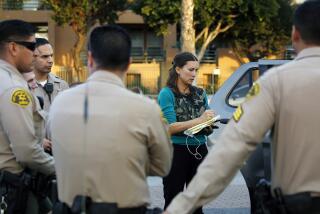New York Times’ Coverage of Florida Rape Case Debated : Ethics: First, the paper printed an inflammatory profile of the alleged victim--including her name. Then it ran a more flattering story about the accused rapist, William Kennedy Smith.
The New York Times is widely regarded as the best and most influential newspaper in the country--and one of the most circumspect. It avoids sensationalism and prurience with an almost Victorian vigor.
But on April 17, the New York Times published a profile of the Palm Beach woman allegedly raped by William Kennedy Smith, nephew of Sen. Edward M. Kennedy (D-Mass.). The profile--which mentioned the woman’s speeding tickets, her out-of-wedlock daughter, her having skipped classes in high school and her frequenting of bars in Palm Beach--quickly became a case study in the pitfalls confronting newspapers when they cover stories that involve sex.
One Times staffer said the story made it look like the woman was a “slut (who) asked for it.” A Times columnist criticized the paper on its own Op-Ed page. More than 300 staffers attended an emotional protest meeting with top Times editors.
National Editor Soma Golden vigorously defends the controversial profile. She says stories about rape victims that include “pimples and all” should be read as saying that even a woman who had what the profile called “a little wild streak” should not be regarded as having “asked” to be raped.
But that is not how the story was generally read.
There is, of course, a legitimate argument to be made for identifying by name the victim in an alleged rape. Why should rape be the only crime in which the suspect is named but the alleged victim is not? Doesn’t that imply that the suspect is guilty--and doesn’t it imply that the victim has something to be ashamed of, that she somehow shares the blame for her victimization? Isn’t that exactly the characterization that many women have long fought against?
But most women still think the victim--not some newspaper editor, male or female--should make that decision. No, newspapers do not permit the people they write about to decide whether the paper will identify them in other situations, but rape is a unique situation. Much as they lament it, most women say there is still a stigma attached to being raped that does not exist for the victim of any other crime. Most editors, male and female, strongly agree--including, until April 17, editors at the New York Times.
But the Times was criticized almost as much for why it named the woman as for having named her.
The Times named the woman, it said in a separate story that accompanied the profile, because NBC had done so the night before, and this nationwide broadcast had taken “the matter of her privacy out of their (editors’) hands.”
But NBC had made its decision to name the woman in part because tabloid newspapers in London and Boca Raton, Fla., had done so. Critics wondered if that meant that New York Times editors were, in effect, letting editors who specialize in publishing photos of bare-breasted women and stories on flying saucers make sensitive decisions for the newspaper that fought in the U.S. Supreme Court to publish the Pentagon Papers.
The problems for the Times did not stop there. Indeed, the good gray lady of American journalism soon began to resemble nothing so much as a clown stumbling through a hall of mirrors with a banana peel under each foot. Over the next two weeks, the Times published two corrections, a story examining the controversy about its actions, and a separate editors’ note in which two top Times editors conceded that the original article had been flawed.
Max Frankel, executive editor of the paper, was quoted in the story as saying the situation was “a crisis because many people feel The Times betrayed its standards.” Although Frankel said the Times had not done so, he conceded: “We did not sufficiently guard against the imputation that we were saying, ‘She deserved it.’ ”
Later, when Smith was charged with rape and battery, the Times not only reversed its field and did not name the woman but published the story on page 18; virtually every other major newspaper in the country--the Washington Post, Los Angeles Times, Chicago Tribune, Boston Globe and USA Today among them--published it on Page 1.
The next day, the New York Times published its long-promised profile of Smith. The story quoted various friends, relatives and acquaintances describing Smith as “a man of gentleness and humor . . . quiet, a little aloof . . . a good, reliable guy . . . .” The story said that attempts to trace rumors of Smith’s previous “aggressiveness toward women in private . . . ended in vague and unverifiable accusation, hearsay or inconclusive silence.”
That story triggered anew criticism of the Times. Why hadn’t the paper been so circumspect in its treatment of the woman Smith is charged with raping?
“We reported hard on the first one and we put in only what we thought we could reliably put in, and we did the same with the second one,” says National Editor Golden.
But prosecutors in the Smith case charged 10 weeks later that Smith had earlier raped another woman--who described him as having been “ferocious, almost animal-like”--and that he had attempted to rape two others. All three women were named in court papers.
Like most major newspapers, the New York Times published stories on these new disclosures. But the disclosures opened the paper to renewed criticism over its flattering profile of Smith.
New York Times reporters interviewed “at least one and maybe two” of the three women when they were working on their profile of Smith, Golden says, “but we couldn’t corroborate their stories, so we didn’t put it in.”
The New York Times did not name the three women. Nor did most other papers, just as most other papers (including the Los Angeles Times) did not name the woman in the alleged Palm Beach rape.
Virtually every major paper (including the Los Angeles Times) did, however, give the story frequent and prominent play. Editors figured that readers were interested in the story; it included three sure-fire topics of titillation--sex, violence and the Kennedys.
More to Read
Sign up for Essential California
The most important California stories and recommendations in your inbox every morning.
You may occasionally receive promotional content from the Los Angeles Times.










